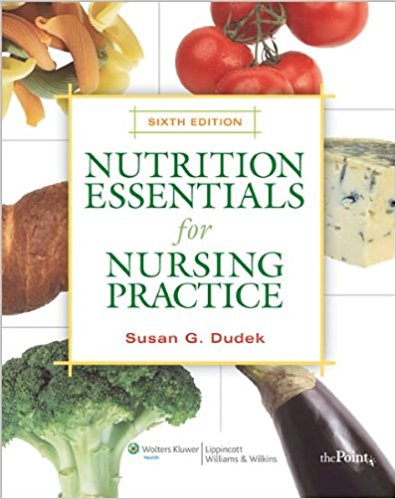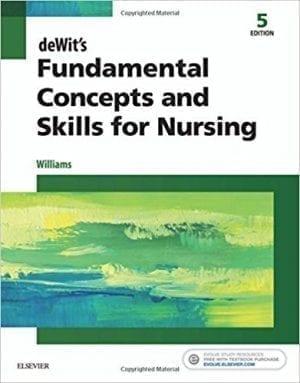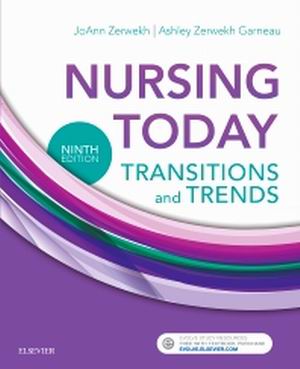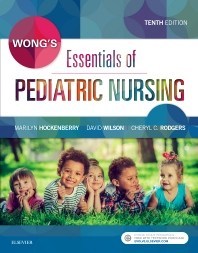Nutrition Essentials for Nursing Practice 6th Edition by Susan G. Dudek – Test Bank
Fat is classified as either “good” fat or “bad” fat, or saturated and unsaturated fatty acids. What is the difference between saturated and unsaturated fatty acids?
A)
The number of carbon atoms
B)
Unsaturated fatty acids have at least one double bond between carbon atoms
C)
The way they are absorbed
D)
Saturated fats are found only in animal products
|
2. |
Many of our foods are now labeled “heart healthy” to designate their nutritional superiority for our body. Which of the following oils is considered “heart healthy”? |
|
A) |
Corn oil |
|
B) |
Olive oil |
|
C) |
Coconut oil |
|
D) |
Sunflower oil |
|
3. |
Linoleic acid and alpha-linoleic acid are two fatty acids considered to be n-3 fatty acids. Another name for these fatty acids is omega-3 fatty acids. What are the best sources of omega-3 fatty acids? |
|
A) |
Cold-water fish, such as mackerel, salmon, sardines, and lake trout |
|
B) |
Meats, such as beef, veal, lamb, and pork |
|
C) |
Foods made with hydrogenated oils, such as cookies, crackers, stick margarine, and shortening |
|
D) |
Milk and milk products |
|
4. |
Cholesterol, a waxy substance found in all cell membranes, is found only in what foods? |
|
A) |
Saturated fats |
|
B) |
Hydrogenated fats |
|
C) |
Foods made from plants |
|
D) |
Animal products |
|
5. |
In the past few years much has been made of trans-fatty acids. The American public has been warned to attempt to eliminate “trans fats” from their diets. Why has this been encouraged? |
|
A) |
Trans-fatty acids raise the level of “bad” cholesterol in the blood. |
|
B) |
Trans-fatty acids lower the level of “bad” cholesterol in the blood. |
|
C) |
Trans-fatty acids are found in coconut, palm, and palm kernel oils. |
|
D) |
Trans-fatty acids account for most fat calories in the average American’s diet. |
|
6. |
Fatty acids are either essential or non-essential. What makes some fatty acids essential? |
|
A) |
They are only found in fish. |
|
B) |
They are saturated fatty acids. |
|
C) |
They cannot be synthesized by the body. |
|
D) |
They are found only in animal products. |
|
7. |
You are eating 1 tablespoon of a salad dressing that contains 14 g of fat and no protein or carbohydrate. How many calories will you consume in the salad dressing? |
|
A) |
76 cal. |
|
B) |
98 cal. |
|
C) |
126 cal. |
|
D) |
140 cal. |
|
8. |
It has been found that fats that are hydrogenated are what? |
|
A) |
Found in cold-water fish |
|
B) |
More likely to oxidize and become rancid than vegetable oils |
|
C) |
More saturated than the original oil from which they were derived |
|
D) |
Less saturated than the original oil from which they were derived |
|
9. |
Nutritional recommendations include lowering the intake of total fat in our diets. What is one strategy we can use to lower total fat intake in our diets? |
|
A) |
Substitute regular margarine for butter. |
|
B) |
Use artificially sweetened soft drinks in place of sweetened drinks. |
|
C) |
Use herbs and spices in place of butter. |
|
D) |
Use olive oil in place of corn oil. |
|
10. |
The recommendation for fat intake in the American diet is what? |
|
A) |
10% of total calories |
|
B) |
20% of total calories |
|
C) |
30% of total calories |
|
D) |
40% of total calories |
|
11. |
Which of the following is true of cholesterol? |
|
A) |
Cholesterol provides 9 cal/g. |
|
B) |
Cholesterol is an essential nutrient because it cannot be synthesized by the body. |
|
C) |
Cholesterol in food comes from plants (the “good” cholesterol) and from animal products (the “bad” cholesterol). |
|
D) |
Cholesterol is used by the body to synthesize bile acids and vitamin D. |
|
12. |
When does the body break down fatty acids incompletely creating an increase in ketone formation? |
|
A) |
Starvation and uncontrolled diabetes |
|
B) |
Periods of high-fat intake |
|
C) |
Coronary heart disease |
|
D) |
Fat malabsorption syndromes |











